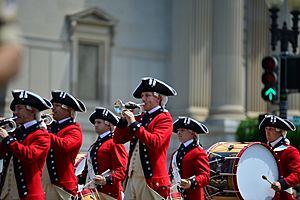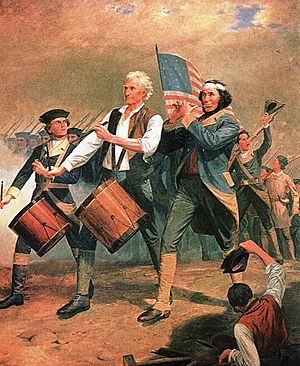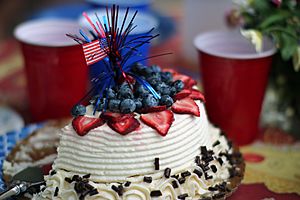Independence Day (United States) facts for kids
Quick facts for kids Independence Day |
|
|---|---|

Displays of fireworks, such as these over the Washington Monument in 1986, take place across the United States on Independence Day.
|
|
| Also called | The Fourth of July The Fourth |
| Observed by | United States |
| Type | National |
| Significance | The day in 1776 that the Declaration of Independence was adopted by the Continental Congress |
| Celebrations | Fireworks, family reunions, concerts, barbecues, picnics, parades, baseball games |
| Date | July 4 |
| Next time | July 4, 2026 |
| Frequency | annual |
Independence Day, often called the Fourth of July or July Fourth, is a special national holiday in the United States. It celebrates the day, July 4, 1776, when the Declaration of Independence was officially accepted. This important document declared that the thirteen American colonies were a new, independent nation called the United States of America, no longer under the rule of the British Empire. Interestingly, the vote to declare independence actually happened two days earlier, on July 2.
People usually celebrate Independence Day with exciting fireworks shows, colorful parades, and fun barbecues. Many families also enjoy picnics, concerts, baseball games, and family reunions. It's a day for everyone to celebrate the history, government, and traditions of the United States. Independence Day is considered the National Day of the United States.
Contents
Why We Celebrate Independence Day
During the American Revolution, the American colonies decided they wanted to be free from Great Britain. On July 2, 1776, the Second Continental Congress (a group of representatives from the colonies) voted to approve a resolution for independence. This resolution was first suggested by Richard Henry Lee from Virginia.
After voting for independence, the Congress focused on writing the Declaration of Independence. This document was created to explain why the colonies were choosing to become independent. A small group, called the Committee of Five, wrote it, with Thomas Jefferson being the main author. The Congress discussed and changed the Declaration's words, finally approving it on July 4.
A day before the Declaration was approved, John Adams wrote to his wife, Abigail. He believed July 2, 1776, would be the most important day in American history. He thought it would be celebrated with festivals, parades, games, and fireworks forever.
However, Adams was off by two days! Americans started celebrating independence on July 4. This was because the Declaration of Independence, which was widely shared, showed the date July 4. Most historians now believe the Declaration was actually signed later, on August 2, 1776, not on July 4.
It's a cool coincidence that two important signers of the Declaration, John Adams and Thomas Jefferson, both later became Presidents. They both died on the same day: July 4, 1826, which was exactly 50 years after the Declaration was approved. Another Founding Father and President, James Monroe, also died on July 4, 1831. He was the third President in a row to die on Independence Day! On a happier note, Calvin Coolidge, the 30th President, was born on July 4, 1872. He is the only U.S. President born on this special day.
How Independence Day is Celebrated
Over the years, Independence Day celebrations have grown and changed.
- In 1777, in Bristol, Rhode Island, thirteen gunshots were fired in the morning and evening on July 4. Philadelphia had a big first anniversary celebration with a dinner for Congress, 13-gun salutes, speeches, music, parades, and fireworks. Ships in the harbor were decorated with red, white, and blue.
- In 1778, General George Washington gave his soldiers extra rum and had an artillery salute. In Paris, France, ambassadors John Adams and Benjamin Franklin hosted a dinner for Americans.
- In 1779, July 4 fell on a Sunday, so the holiday was celebrated on Monday, July 5.
- In 1781, Massachusetts was the first state to officially recognize July 4 as a state holiday.
- In 1783, Moravians in Salem, North Carolina, held a celebration with a special music program called The Psalm of Joy. This is known as the first recorded celebration there, and they still celebrate it today.
- In 1870, the U.S. Congress made Independence Day a holiday for federal employees, but they didn't get paid for it.
- In 1938, Congress changed it to a paid federal holiday, meaning federal employees got the day off with pay.
Independence Day Traditions

Independence Day is a national holiday filled with patriotic displays. Many celebrations happen outdoors, especially since it's in the summer. Because it's a federal holiday, many government offices, like the post office and federal courts, are closed. Many politicians also attend public events to talk about the nation's history and values.
Families often celebrate by having or going to a picnic or barbecue. Many people use the day off, and sometimes a long weekend, to gather with family or friends. Decorations, like streamers, balloons, and clothes, are usually red, white, and blue, matching the colors of the American flag. Parades are often held in the morning, and fireworks displays happen in the evening after dark, usually in parks or town squares.
In the past, the night before the Fourth was a big part of the celebrations. People would have loud gatherings, often with large bonfires. In New England, towns would compete to build huge pyramids of barrels and casks. These were lit at nightfall to start the celebration. The tallest bonfires ever recorded were in Salem, Massachusetts, with pyramids made of up to forty layers of barrels. This tradition was popular in the 19th and 20th centuries and is still done in some New England towns today.
Independence Day fireworks are often set to patriotic songs. These include the national anthem "The Star-Spangled Banner," "God Bless America," "America the Beautiful," "My Country, 'Tis of Thee," "This Land Is Your Land," and "Stars and Stripes Forever." Some songs, like "Yankee Doodle" and "Dixie," remind people of the Revolutionary War or the War of 1812.
Many states have fireworks shows, and people also buy fireworks for personal use. However, because of safety concerns, some states have banned fireworks or limited the types allowed. Local weather, especially dry conditions, can also lead to bans on fireworks sales or use. Even if personal fireworks are banned, professional displays (like at sports events) might still happen if safety rules are followed.
On Independence Day, a "salute to the union" is fired at noon by military bases. This means one gun is fired for each state in the United States.
In 2009, New York City had the biggest fireworks display in the country, using over 22 tons of fireworks. They usually have shows over the East River. Other large displays happen in Chicago over Lake Michigan, in San Diego over Mission Bay, in Boston on the Charles River, in St. Louis on the Mississippi River, in San Francisco over the San Francisco Bay, and on the National Mall in Washington, D.C.
During the annual Windsor-Detroit International Freedom Festival, Detroit, Michigan, hosts one of the world's largest fireworks displays over the Detroit River. This celebrates Independence Day along with Windsor, Ontario's celebration of Canada Day.
The first week of July is usually one of the busiest travel times in the United States. Many people use the often three-day holiday weekend for longer vacation trips.
Famous Celebrations
- The Bristol Fourth of July Parade in Bristol, Rhode Island, has been held since 1785. It is the oldest continuous Independence Day celebration in the United States.
- Since 1868, Seward, Nebraska, has held a celebration on its town square. In 1979, Congress named Seward "America's Official Fourth of July City-Small Town USA." Seward is a town of 6,000 people, but it grows to over 40,000 during the July 4 celebrations.
- Since 1912, the Rebild Society, a Danish-American friendship group, has held a July 4 weekend festival in Rebild municipality in Denmark. It's a homecoming for Danish-Americans.
- Since 1959, the International Freedom Festival is held jointly in Detroit, Michigan, and Windsor, Ontario. It celebrates both Independence Day and Canada Day (July 1) and ends with a huge fireworks display over the Detroit River.
- The famous Macy's fireworks display in New York City, usually over the East River, has been shown on NBC nationwide since 1976. In 2009, it moved to the Hudson River to celebrate 400 years since Henry Hudson explored that river.
- On the Capitol lawn in Washington, D.C., A Capitol Fourth is a free concert. It's broadcast live by PBS, NPR, and the American Forces Network. Over half a million people attend this concert before the fireworks.
| U.S. federal holidays |
|---|
| New Year's Day | Martin Luther King, Jr. Day | Presidents' Day | Memorial Day | Independence Day Labor Day | Columbus Day | Veterans Day | Thanksgiving Day | Christmas Day |
Images for kids
-
Independence Day issue of The Saturday Evening Post, 1924
-
Fireworks over the National Mall in Washington, D.C. every July 4 are preceded by a concert known as A Capitol Fourth, which takes place outside the U.S. Capitol and is televised on the American public television network PBS.
-
In addition to a fireworks show, Miami, Florida, lights one of its tallest buildings with the patriotic red, white and blue color scheme on Independence Day.
-
New York City's fireworks display, shown above over the East Village, is sponsored by Macy's and is the largest in the country.
-
Towns of all sizes hold celebrations. Shown here is a fireworks display in America's most eastern town, Lubec, Maine, population 1,300. Canada is across the channel to the right.
-
Fireworks in Narberth, Pennsylvania.
See also
 In Spanish: Día de la Independencia de los Estados Unidos para niños
In Spanish: Día de la Independencia de los Estados Unidos para niños












